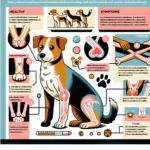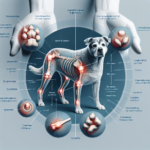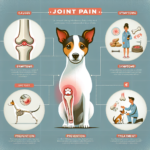Danish-Swedish Farmdog Joint Pain: Causes, Symptoms, Prevention, and Treatment

Introduction
The Danish-Swedish Farmdog, also known as the Dansk-Svensk Gårdshund, is a small, versatile breed that originated in Denmark and Sweden. Historically, these dogs were used on farms for various tasks, including hunting vermin, guarding property, and herding livestock. Known for their agility, intelligence, and friendly disposition, Danish-Swedish Farmdogs are beloved family pets and working dogs. They typically have a short, smooth coat and a compact, muscular build, making them well-suited for active lifestyles.
Like many breeds, Danish-Swedish Farmdogs are prone to certain health issues, with joint pain being a significant concern. Joint health is crucial for this breed due to their active nature and the physical demands placed on them. Understanding the causes, symptoms, prevention, and treatment of joint pain in Danish-Swedish Farmdogs can help owners ensure their pets lead healthy, pain-free lives.
Breed-Specific Joint Pain Risks
Genetic Predisposition
Danish-Swedish Farmdogs, like many other breeds, can be genetically predisposed to joint-related issues. Common conditions include hip dysplasia, elbow dysplasia, and arthritis. Hip dysplasia occurs when the hip joint does not fit properly into the hip socket, leading to pain and mobility issues. Elbow dysplasia involves abnormal development of the elbow joint, causing lameness and discomfort. Arthritis, a degenerative joint disease, can develop as a result of these conditions or independently, leading to chronic pain and stiffness.
Age-Related Risks
As Danish-Swedish Farmdogs age, the risk of developing joint pain increases. While young dogs may show early signs of joint issues, symptoms often become more pronounced as they reach middle age and beyond. Owners should be vigilant about monitoring their dogs for signs of joint pain, particularly as they approach the age of seven or eight, when age-related joint degeneration is more likely to occur.
Activity Level and Joint Stress
Danish-Swedish Farmdogs are known for their high energy levels and love of physical activity. While regular exercise is essential for their overall health, excessive or inappropriate activity can place undue stress on their joints. Activities such as jumping, running on hard surfaces, or engaging in high-impact sports can exacerbate joint issues. Owners should balance their dogs’ need for exercise with the importance of protecting their joints from excessive strain.
Common Symptoms of Joint Pain in Danish-Swedish Farmdogs
General Symptoms
Owners should be aware of the following common symptoms of joint pain in Danish-Swedish Farmdogs:
- Limping: A noticeable limp or favoring one leg over another can indicate joint pain.
- Stiffness: Difficulty moving, especially after rest, may be a sign of joint discomfort.
- Reluctance to Move: A dog that is hesitant to jump, climb stairs, or engage in physical activity may be experiencing joint pain.
- Swelling: Visible swelling around the joints can be a symptom of inflammation and pain.
- Behavioral Changes: Increased irritability, lethargy, or changes in appetite can also indicate joint pain.
Breed-Specific Symptoms
In Danish-Swedish Farmdogs, joint pain may manifest in specific ways due to their unique build and activity levels. Owners should watch for signs such as:
- Difficulty Herding or Working: A reluctance to perform tasks they previously enjoyed, such as herding or hunting, can be a red flag.
- Changes in Gait: An altered gait, such as a bunny hop or a stiff-legged walk, may indicate joint issues.
When to Consult a Vet
If any of the above symptoms are observed, it is crucial to consult a veterinarian promptly. Early diagnosis and intervention can significantly improve the quality of life for a dog suffering from joint pain. A vet can perform a thorough examination, including imaging tests like X-rays, to determine the underlying cause of the pain and recommend appropriate treatment options.
Preventive Measures for Joint Health
Exercise Recommendations
Regular, moderate exercise is essential for maintaining joint health in Danish-Swedish Farmdogs. Activities such as walking, swimming, and controlled play can help keep their joints flexible and muscles strong without causing excessive strain. Owners should avoid high-impact activities like jumping or running on hard surfaces, which can exacerbate joint issues.
Dietary Suggestions
A balanced diet rich in essential nutrients can support joint health. Foods containing glucosamine, chondroitin, and omega-3 fatty acids are particularly beneficial. These nutrients help reduce inflammation, support cartilage health, and improve joint function. Owners may also consider supplements specifically designed for joint health, but it is essential to consult a veterinarian before adding any new supplements to their dog’s diet.
Weight Management
Maintaining a healthy weight is crucial for reducing joint stress in Danish-Swedish Farmdogs. Excess weight places additional pressure on the joints, exacerbating pain and discomfort. Owners should monitor their dog’s weight and adjust their diet and exercise routine as needed to ensure they remain within a healthy weight range. Regular vet check-ups can help track weight and overall health.
Early Screening and Monitoring
Early screening for joint issues can help catch problems before they become severe. Regular veterinary check-ups, including orthopedic evaluations, can identify early signs of joint pain. For breeds like the Danish-Swedish Farmdog, which are prone to genetic joint issues, breeders may also perform genetic testing to identify potential risks in puppies.
Treatment Options for Joint Pain
Non-Surgical Treatments
Non-surgical treatments for joint pain in Danish-Swedish Farmdogs include:
- Medications: Anti-inflammatory drugs, pain relievers, and joint supplements can help manage pain and inflammation.
- Physical Therapy: Exercises and therapies designed to improve joint function and reduce pain can be highly effective.
- Lifestyle Adjustments: Modifying the dog’s activity level and environment to reduce joint stress can help manage pain.
Surgical Options
In severe cases, surgical intervention may be necessary. Common surgical options include:
- Joint Replacement: Replacing a damaged joint with an artificial one can significantly improve mobility and reduce pain.
- Arthroscopy: A minimally invasive procedure to clean out the joint and remove damaged tissue.
- Osteotomy: Cutting and realigning bones to improve joint function and reduce pain.
Surgical options should be discussed with a veterinarian to determine the best course of action based on the dog’s specific condition and overall health.
Alternative Therapies
Alternative therapies can complement traditional treatments and provide additional relief for joint pain. These may include:
- Acupuncture: This ancient practice can help reduce pain and inflammation by stimulating specific points on the body.
- Hydrotherapy: Water-based exercises can improve joint function and reduce pain without placing stress on the joints.
- Massage: Regular massage can help improve circulation, reduce muscle tension, and alleviate pain.
Lifestyle and Management Tips
Daily Care Routine
A consistent daily care routine can help manage and alleviate joint pain in Danish-Swedish Farmdogs. This may include:
- Regular Exercise: Engage in low-impact activities like walking or swimming to keep joints flexible.
- Balanced Diet: Provide a diet rich in joint-supporting nutrients and maintain a healthy weight.
- Medication Management: Administer any prescribed medications or supplements as directed by the veterinarian.
- Monitoring: Keep an eye on the dog’s behavior and mobility, noting any changes that may indicate increased pain.
Modifying the Home Environment
Making the home environment more comfortable for a dog suffering from joint pain can significantly improve their quality of life. Consider the following modifications:
- Ramps: Use ramps to help the dog navigate stairs or get onto furniture without jumping.
- Orthopedic Beds: Provide a supportive, comfortable bed to reduce pressure on the joints during rest.
- Non-Slip Flooring: Ensure floors are non-slip to prevent falls and reduce joint strain.
Long-Term Management
Long-term management strategies for keeping a Danish-Swedish Farmdog active and happy despite joint pain include:
- Regular Vet Check-Ups: Schedule regular veterinary visits to monitor joint health and adjust treatment plans as needed.
- Consistent Routine: Maintain a consistent exercise and care routine to support joint health.
- Adapt Activities: Modify activities to suit the dog’s capabilities, ensuring they remain engaged and active without overexertion.
FAQs About Danish-Swedish Farmdogs and Joint Pain
What are the early signs of joint pain in Danish-Swedish Farmdogs?
Early signs of joint pain include limping, stiffness, reluctance to move, and changes in behavior such as increased irritability or lethargy.
Can joint pain in Danish-Swedish Farmdogs be prevented?
While genetic predispositions cannot be entirely prevented, maintaining a healthy weight, providing a balanced diet, and engaging in appropriate exercise can help reduce the risk of joint pain.
Are there specific exercises that are better for Danish-Swedish Farmdogs with joint pain?
Low-impact exercises such as walking, swimming, and controlled play are ideal for dogs with joint pain. Avoid high-impact activities that can exacerbate joint issues.
What dietary supplements can help with joint pain in Danish-Swedish Farmdogs?
Supplements containing glucosamine, chondroitin, and omega-3 fatty acids can support joint health and reduce inflammation. Always consult a veterinarian before adding supplements to your dog’s diet.
When should I consider surgery for my Danish-Swedish Farmdog’s joint pain?
Surgery may be considered if non-surgical treatments are ineffective and the dog’s quality of life is significantly impacted. Consult with a veterinarian to determine the best course of action.
Conclusion
Joint pain is a common concern for Danish-Swedish Farmdogs, but with proper care and attention, it can be managed effectively. By understanding the causes, symptoms, prevention, and treatment options, owners can help their dogs lead healthy, active lives. Regular veterinary check-ups, a balanced diet, appropriate exercise, and a supportive home environment are key to maintaining joint health. Taking proactive measures and consulting with a veterinarian at the first sign of joint pain can make a significant difference in the well-being of these beloved dogs.




